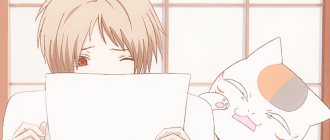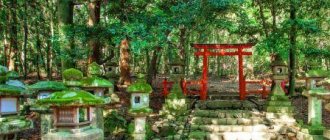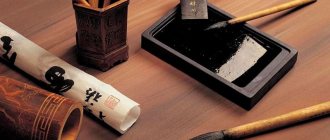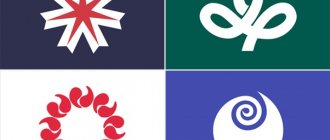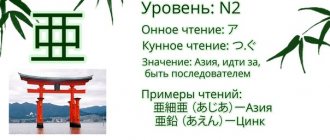The first question for people unfamiliar with Japanese culture is: manga - what is it? The second question is why there is the term Japanese manga? First things first. Manga are black and white comics in which the text is read from right to left (the reason is a feature of Japanese writing). Japanese manga are classic Japanese comics, where the text is written in the form of hieroglyphs, and the style of the characters is typically anime.
First appearance
Who came up with these illustrated stories? The question is not easy, and to answer it, we need to delve into the past. The history of this creativity goes back to the Middle Ages. A 12th-century Buddhist monk named Toba created illustrated stories about animal people and disobedient Buddhists. These stories are written on paper scrolls, with drawings and captions made in ink. Interesting: already in these stories images of rapidly moving human legs appeared. These works can be considered the first manga.
Demon Slayer: Kimetsu no Yaiba
With the explosive popularity the series has enjoyed this year, Demon Slayer only reaching second place is probably the biggest surprise of this election. The story of a boy who learns to fight demons in an attempt to save his own demon sister has broken sales records in both movie theaters and bookstores, but has yet to take the number one spot in people's hearts and minds... yet.
A little history
At the end of the 19th century, the visual art of ukiyo-e (the prototype of Japanese manga) merged with the technique of American comics. If before this it was believed that the meaning of the drawings and the idea were more important than the form, then by the beginning of the 20th century the opinion had changed.
From 1900 to 1940, Japanese manga was a youth fashion. From 1940 to 1945, the country's government decided to use art for propaganda, and as a result, one type of Japanese manga called Tokyo manga appeared. After the war, the city of Osaka began printing comics on cheap paper and selling them for free.
Then those nuances appeared, without which modern Japanese comics are unthinkable: sound effects, time-lapse images of movements, close-ups. Japanese feature-length cartoons and animated series, that is, anime, are based on manga. In other words, without comics there would be no cartoons.
The Birth of Japanese Manga
The history of manga is largely connected with the history of Japanese art. Although manga as we know it today first appeared after World War II, the first manga appeared in Japan back in the 13th century in the form of a book with moving animals drawn in it called Chouju-giga (鳥獣戯画).
Something incredibly innovative at the time, the designs in this collection were created with sweeping brush strokes that created a sense of movement. A similar technique is characteristic of modern Japanese manga and was introduced during the Edo period (1603-1868) by Toba-e (鳥羽絵) artists.
Bordering on the cartoonish, Toba-e's gave rise to Japan's first rasterization: a technique that manipulates light to create a dynamic environment around a drawing.
It was then that the word “manga” first appeared. It was first used in 1798 for the title of Sando Kyoden's Shiji no yukikai, a collection of drawings depicting scenes from everyday life. The expression was subsequently used throughout the century and eventually came to be used to refer to the printed ukiyo-e made popular by Hokusai.
In the 20th century, this word takes on a new meaning. Used in propaganda during World War II, manga becomes one of the most important symbols of Japanese visual art. It causes a boom in the literary industry and becomes popular abroad.
Today, manga remains the main "ambassador" of Japanese culture abroad, its unique universes greatly distinguishing it from Western comics.
Heroes in manga
Anyone who first heard about these unique comics involuntarily asks several questions. What does this or that character look like, what are the differences between good characters and bad characters? Is it true that an antagonist and a villain are the same thing?
When talking about heroes and villains, it is always worth remembering that the characters are very controversial. They are called Akunins - standing between good and evil. It is through illustrated stories that readers learn that it is wrong to confuse the concepts of “villain” and “antagonist.”
The antagonist seeks to prevent the protagonist from achieving his goals, while trying to “get through” to the enemy and warning that stubbornness is fraught with disaster. The villain is a deliberately dishonest character, extremely cruel, eager to achieve selfish goals by any means. A clear conclusion can be drawn: any villain can be called an antagonist, but not vice versa.
History of manga
The history of manga dates back to scrolls dating back to the 12th century. However, whether these scrolls were manga or not is still a matter of debate - experts believe that it was they who first laid the foundations for reading from right to left. Other authors place the origins of manga closer to the 18th century. Manga is a Japanese term that loosely means “comic” or “animation,” literally “whimsical sketches.” Historians and writers dealing with the history of manga have described two main processes that influenced modern manga. Their views differed in terms of time - some scholars paid special attention to cultural and historical events following World War II, others described the role of the pre-war Meiji period and the pre-Restoration period in Japanese culture and art.
The first point of view emphasizes events that occurred during and after the occupation of Japan (1945–1952), and points out that manga was greatly influenced by the cultural assets of the United States - American comic books that were brought to Japan by military personnel, as well as images and themes American television, films and cartoons (in particular those created by the Walt Disney company). According to Sharon Kinsella, the booming publishing industry in post-war Japan helped create a consumer-oriented society, with publishing giants such as Kodansha achieving success.
Before World War II
Many writers, such as Takashi Murakami, emphasize the importance of the events following World War II, while Murakami believes that Japan's defeat in the war and the subsequent atomic bombings of Hiroshima and Nagasaki dealt a severe blow to the Japanese artistic consciousness, which had lost its former self-confidence and began to seek solace in harmless and cute drawings called kawaii. At the same time, Takayumi Tatsumi assigns a special role to economic and cultural transnationalization, which laid the foundation for the postmodern and international culture of animation, filmography, television, music and other popular arts, and became the basis for the development of modern manga.
For Murakami and Tatsumi, transnationalization (or globalization) meant primarily the transfer of cultural values from one nation to another. In their view, this term does not mean either international corporate expansion, or international tourism, or cross-border personal friendships, but is used specifically to denote the artistic, aesthetic and intellectual exchange of traditions between several peoples. An example of cultural transnationalization is the creation in the United States of the Star Wars film series, from which Japanese manga artists subsequently created manga, which was later sold in the United States. Another example is the transition of hip-hop culture from the United States to Japan. Wendy Wong also sees a major role of transnationalization in the modern history of manga.
Other scholars have emphasized the inextricable connection between Japanese cultural and aesthetic traditions and the history of manga. These included American writer Frederick L. Schodt, Kinko Ito and Adam L. Kern. Schodt referred to 13th-century scrolls with pictures like the Choju-jimbutsu-giga, which humorously told stories in pictures. He also emphasized the connection between the visual styles of ukiyo-e and shunga with modern manga. There is still some debate as to whether the first manga was chōjugiga or shigisan-engi—both manuscripts date from the same time period. Isao Takahata, co-founder and head of Studio Ghibli, claims that there is no connection between these scrolls and modern manga. One way or another, it was these scrolls that laid the foundations for the right-to-left reading style used in manga and Japanese books.
Schodt also assigns a particularly significant role to the kamishibai theater, when traveling artists showed drawings to the public in their performances. Torrance noted the similarities between modern manga and Osaka's popular novels of the 1890–1940 period, and argued that the creation of widespread literature during and before the Meiji period helped create audiences willing to embrace words and pictures simultaneously. The connection of manga with the art of the pre-Restoration period is also noted by Kinko Ito, although, in her opinion, the events of post-war history served as a lever for the formation of consumer demand for manga rich in drawings, which contributed to the establishment of a new tradition of its creation. Ito describes how this tradition influenced the development of new genres and consumer markets, such as “manga for girls” (shojo), which developed in the late 1960s, or “comics for ladies” (josei).
Kern suggested that the illustrated books of 18th-century kibyoshi may be considered the world's first comics. These stories, like modern manga, deal with comedic, satirical, and romantic themes. Although Kern does not believe that kibyoshi was a direct predecessor of manga, the existence of this genre, in his opinion, had a significant influence on the relationship between text and drawings. The term "manga" was first mentioned in 1798 and meant "whimsical or improvised drawings"; Kern emphasizes that the word predates the then better-known term “Hokusai manga,” which was used for several decades to refer to the works of Katsushika Hokusai.
Charles Inouye similarly sees manga as a mixture of word and text elements, each of which first arose before the United States occupation of Japan. In his view, Japanese pictorial art was inextricably linked with Chinese graphic art, while the development of verbal art, in particular the creation of the novel, was stimulated by the social and economic needs of the Meiji and pre-war populations united by a common written language. Inoue treats both of these elements as symbiosis in the manga.
Thus, scholars view the history of manga as a connection to a historical and cultural past that was subsequently significantly influenced by post-war innovation and transnationalization.
After World War II
Modern manga began to emerge during the occupation period (1945–1952) and developed in the post-occupation years (1952–early 1960s), when previously militaristic and nationalistic Japan began rebuilding its political and economic infrastructure. And although the US censorship policy prohibited the creation of works of art praising war and Japanese militarism, it did not apply to other publications, including manga. In addition, the Japanese Constitution (Article 21) prohibited any form of censorship. As a result, creative activity began to increase during this period. It was then that two manga series were created, which had a significant impact on the entire future history of manga. The first manga was created by Osamu Tezuka and was called Mighty Atom (known as Astro Boy in the USA), the second manga was Sazae-san by Machiko Hasegawa.
Astro Boy is a robot endowed with enormous abilities, and at the same time a naive little boy. Tezuka never talked about why his hero had such a developed social consciousness, nor about what program could make the robot so humane. Astro Boy has both a conscience and humanity - reflecting Japanese sociability and socially oriented masculinity, very different from the desire for Emperor worship and militarism inherent in the period of Japanese imperialism. The Astro Boy series quickly gained great popularity in Japan (and remains so to this day), Astro Boy became a symbol and hero of the new world, striving for renunciation from war, as also stated in Article 9 of the Japanese Constitution. Similar themes appear in Tezuka's works New World and Metropolis.
The manga Sazae-san began to be drawn in 1946 by a young mangaka, Machiko Hasegawa, who made her heroine look like millions of people left homeless after the war. Sazae-san doesn't have an easy life, but she, like Astro Boy, is very human and deeply involved in the lives of her large family. She is also a very strong personality, which is the opposite of the traditional Japanese principle of feminine gentleness and obedience; She adheres to the principle of “good wife, wise mother” (“ryosai kenbo”, りょうさいけんぼ; 良妻賢母). Sazae-san is cheerful and able to quickly restore strength; Hayao Kawai calls this type a “steadfast woman.” Sales of the Sazae-san manga amounted to more than 62 million copies by the second half of the 20th century.
Tezuka and Hasegawa became innovators in terms of drawing style. Tezuka's "cinematic" technique was characterized by the fact that manga frames were in many ways reminiscent of film frames - the depiction of details of fast action borders on a slow transition, and distant distance is quickly replaced by close-up. To simulate moving images, Tezuka combined the arrangement of frames to suit the viewing speed. When creating manga, as when creating a film, the author of the work was considered the person who determined the mutual distribution of frames, and the drawing of images in most cases was carried out by assistants. This style of visual dynamics was later adopted by many manga artists. The focus on themes of everyday life and women's experiences reflected in Hasegawa's work later became one of the hallmarks of shōjo manga.
Between 1950 and 1969, readership grew steadily, and two main genres of manga began to emerge: shonen (manga for boys) and shoujo (manga for girls). Since 1969, shoujo manga has been drawn primarily by adult men for young female readers.
The two most popular shōjo manga of the period were Tezuka's Ribon no Kishi (Princess Knight or Knight in Ribbons) and Mitsuteru Yokoyama's Mahōtsukai Sarii (Sally the Witch). Ribon no Kishi tells the story of the adventures of Princess Sapphire, who from birth received two souls (female and male) and learned to wield a sword perfectly. Sally, the main character of Mahōtsukai Sarii, is a little princess who came to Earth from the magical world. She goes to school and uses magic to do good deeds for her friends and classmates. The manga Mahōtsukai Sarii was inspired by the American sitcom Bewitched, but unlike Samantha, the protagonist of Bewitched in adulthood, Sally is an ordinary teenage girl who is growing up and learning to take on the responsibilities of approaching adulthood. Thanks to Mahōtsukai Sarii, the maho-shojo ("magical girl") subgenre was created, which subsequently gained popularity.
Shoujo manga
In 1969, the collective of women mangaka Union 24 was formed. The group included Hagio Moto, Riyoko Ikeda, Yumiko Oshima, Keiko Takemiya and Ryoko Yamagishi; the group was considered the first group of women to start drawing manga. After this, female manga artists became the main creators of shoujo manga.
In 1971, Ikeda began work on the eventually popular manga Berusaiyu no Bara (The Rose of Versailles), set in pre-revolutionary France. The plot tells the story of a woman named Oscar, who became the captain of Marie Antoinette's guard. In the end, Oscar dies during the storming of the Bastille. In 1975, They Were Eleven was a science fiction story in which the main character is a cadet at a future space academy.
The women of the Union of 24 Years group also made significant stylistic innovations. The story focuses on the inner experience and feelings of the main character, and the shoujo manga itself acts as a “picture poem.” There are elegant and complex designs, and frame boundaries are often eliminated. All of these innovations—a strong and independent heroine, the intense overall emotionality of the work, and subtle art design—are still the main characteristics of shoujo manga.
1975–present
In subsequent decades (1975-present), along with the development of shoujo manga, its subgenres began to appear. The main ones among them were romance, superheroines and “ladies' comics” (similar names to radisu レディース, redikomi レヂィーコミ and josei 女性 じょせい); In many ways, these subgenres overlapped.
In modern romantic shoujo manga, the main theme is love, and the storytelling style in such works is usually very emotional. Japanese anime and manga critic Eri Izawa defines the romance genre as symbolizing “the emotional, the grand, and the epic; a sense of heroism, fantastic adventure and melancholy; passionate love, internal struggle and eternal desire”, which merge into one bright, individual and passionate story, enclosed in manga frames. These stories are sometimes quite long and often straddle the line between fake and real love, and usually take place in a confusing world. The theme of growing up occurs in both shojo and shonen manga.
In a novel of education, the protagonist usually experiences unhappiness and conflict in his development; A similar phenomenon occurs in shoujo manga. For example, the manga Peach Girl by Miwa Ueda, Mars by Fuyumi Soryo. Examples of more mature works: Happy Mania by Moyoko Anno, Tramps Like Us by Yayoi Ogawa and Nana by Ai Yazawa. In some shoujo works, a young heroine finds herself in an alien world, where she meets others and tries to survive (They Were Eleven by Hagio Moto, From Far Away by Kyoko Hikawa, and The World Exists For Me by Chiho Saito).
Also in the plots of shojo manga there are situations when the protagonist encounters unusual or strange people and phenomena, such as in the manga Fruits Basket by Takai Natsuki, which gained popularity in the United States. The main character, Tohru, remains to live in a forest house with people who turn into animals from the Chinese zodiac. In the manga Crescent Moon, the heroine Mahiru encounters a group of supernatural beings and eventually learns that she too has superpowers.
With the advent of superheroine stories in shoujo manga, traditional norms about female submissiveness began to break down. Sailor Moon manga by Naoko Takeuchi is a long story about a group of young girls who are at once heroic and introspective, energetic and emotional, submissive and ambitious. This combination proved extremely successful, and the Sailor Moon manga and anime gained international popularity. Another example of a story about superheroines is the manga of the group CLAMP Magic Knight Rayearth, the main heroines of which find themselves in the world of Cephiro and become magical warriors who save Cephiro from internal and external enemies.
In works about superheroines, the concept of sentai is quite common, used to refer to a team of girls, for example, the Sailor Warriors from Sailor Moon, the Magic Knights from Magic Knight Rayearth, and the Mew Mew team from Tokyo Mew Mew. Today, the superheroine theme template is widely used and the subject of parodies (Wedding Peach and Hyper Rune); The bishōjo (Galaxy Angel) genre is also widespread.
In the mid-1980s and beyond, a subgenre of shōjo manga aimed at young women began to emerge. This subgenre of "ladies' comics" ("josei" or "radisu") dealt with themes of youth: work, emotions, problems of sexual relations, friendships (and sometimes love) between women.
Josei manga retained the basic style previously used in shojo manga, but now the story was intended for adult women. Sexual relationships were often openly depicted as part of a complex narrative in which sexual pleasure was coupled with emotional experience. Examples include Ryo Ramii's Luminous Girls, Masako Watanabe's Kinpeibai, and the work of Shungisu Uchida. Also in josei manga, sexual relationships between women (yuri) can occur, as reflected in the works of Erika Sakurazawa, Ebine Yamaji, and Chiho Saito. There are also other themes, such as fashion manga (Paradise Kiss), gothic vampire manga (Vampire Knight, Cain Saga and DOLL), as well as various combinations of street fashion, cosplay and J-Pop music.
Shonen, seinen and seijin
Manga for a male readership can be classified according to several criteria. One of these is the age category: shonen manga is intended for boys under 18 years of age, and seinen manga is intended for men aged 18 to 30 years. In addition, manga can be divided by component - usually in male manga there are themes of adventure, dark humor, themes of honor and sometimes sexual relationships. In Japanese, different kanji are used to denote closely related concepts of seinen: 青年, which means “youth, young man,” and 成年, “adult.” The latter term refers to sexually explicit manga intended for adults; There is also a synonym "seijin" ("adult", 成人). All three types of manga are similar in many ways.
Boys and young men were among the early readership that formed after the Second World War. Since the 1950s, shonen manga has focused on themes that appeal to the average boy: science fiction (robots and space travel) and heroic adventures. Stories often depict tests of the protagonist's abilities and skills, self-improvement, self-control, sacrifice for duty, honest service to society, family and friends.
Superhero manga like Superman, Batman and Spider-Man have not become as popular as the shonen genre. The exception was Kiya Asamiya's work Batman: Child of Dreams, published in the United States by DC Comics and in Japan by Kodansha. However, lone heroes appear in the works of Golgo 13 and Lone Wolf and Cub. In Golgo 13, the main character is an assassin dedicated to serving world peace and other social causes. Ogami Itto, a swordsman from Lone Wolf and Cub, is a widower raising his son Daigoro and wanting revenge on his wife's killers. The heroes of both mangas are ordinary people who do not have superpowers. Both stories take a “journey into the hearts and minds of the characters,” revealing their psychology and motivations.
Many shonen manga works deal with themes of science fiction and technology. Early examples of robot manga include Astro Boy and Doraemon, a manga about a robot cat and its owner. The robot theme has evolved widely, from Mitsuteru Yokoyama's Tetsujin 28-go to more complex storylines in which the protagonist must not only destroy enemies, but also overcome himself and learn to control and interact with his robot. Thus, in Neon Genesis Evangelion, the main character Shinji opposes not only his enemies, but also his own father, and in Vision of Escaflowne Van, waging a war against the Dornkirk Empire, has to face mixed feelings towards Hitomi.
Another popular theme in shonen manga is sports. These stories emphasize self-discipline; Manga often depicts not only exciting sports competitions, but also the personal qualities the protagonist needs to overcome his limit and achieve success. The theme of sports is touched upon in Tomorrow's Joe, One-Pound Gospel and Slam Dunk.
Adventure stories in both shonen and shoujo manga often feature supernatural settings where the protagonist faces trials. From time to time he fails, for example in Death Note the main character Light Yagami receives a Shinigami book that kills anyone whose name is written in it. Another example is the manga The Demon Ororon, in which the main character renounces the rule of Hell in order to live on earth as a mere mortal. Sometimes the main character himself has superpowers, or fights with characters who have them: Hellsing, Fullmetal Alchemist, Flame of Recca and Bleach.
Stories about war in the modern world (or World War II) remain suspect of glorifying the history of the Japanese Empire and have not found their way into shonen manga. However, stories about fantasy or historical wars were not banned, and manga about heroic warriors and martial artists became very popular. Moreover, in some of these works there is a dramatic plot, for example in The Legend of Kamui and Rurouni Kenshin; and others have humorous elements, like Dragon Ball.
Although modern war stories do exist, they tend to deal more with the psychological and moral issues of war. Such stories include Who Fighter (a retelling of Joseph Conrad's Heart of Darkness about a Japanese colonel who betrays his country), The Silent Service (about a Japanese nuclear submarine) and Apocalypse Meow (about the Vietnam War, told from the point of view of an animal). Other action manga usually feature plots about criminal or espionage organizations that the main character opposes: City Hunter, Fist of the North Star, From Eroica with Love (which combines adventure, action and humor).
According to manga critics Koji Aihara and Kentaro Takekuma, such battle stories endlessly repeat the same theme of mindless cruelty, which they sarcastically label "Shonen Manga Plot Shish Kebob". Other experts suggest that the depiction of battles and cruelty in comics serves as a kind of “outlet for negative emotions.” War stories are the subject of parodies, one of which is the comedy Sgt. Frog is about a squad of frog aliens who invade Earth and end up taking up residence with Hinata's family.
The role of women in manga for men
In early shonen manga, the main roles belonged to boys and men, while women were assigned mainly to the roles of sisters, mothers and girlfriends. In the Cyborg 009 manga, there is only one cyborg girl. More recent manga feature virtually no women, including Keisuke Itagaki's Baki the Grappler and Akira Toriyama's Sand Land. However, starting in the 1980s, women began to play more significant roles in shonen manga, such as Toriyama's Dr. Slump, whose main character is a powerful, but at the same time mischievous robot.
Subsequently, the role of women in manga for men changed significantly. Bishōjo style began to be used. In most cases, the woman is the object of the protagonist's emotional affection, such as Verdandi from Oh My Goddess! and Shao-lin from Guardian Angel Getten. In other stories, the protagonist is surrounded by several women: Negima!: Magister Negi Magi and Hanaukyo Maid Team. The main character does not always manage to form a romantic relationship with the girl (Shadow Lady), in the opposite cases the sexual activity of the couple may be shown (or implied), as in Outlanders. Initially naive and immature, the hero matures and learns relationships with women: Yota from Video Girl Ai, Makoto from Futari Ecchi. In seijin manga, sexual relations are taken for granted and depicted openly, such as in the works of Toshiki Yui or Were-Slut and Slut Girl.
Heavily armed female warriors ("sento bishojo") are another class of women found in manga for men. Sometimes sento bishoujo are cyborgs, like Alita from Battle Angel Alita, Motoko Kusanagi from Ghost in the Shell, or Chise from Saikano; others are ordinary people: Attim from Seraphic Feather, Kalura from Drakuun and Falis from Murder Princess.
In the early 1990s, due to the easing of censorship in Japan, explicit sexual themes became widespread in manga and were not censored in English translations. The spectrum ranged from partial depiction of nudity to open display of sexual acts, sometimes depicting sexual slavery and sadomasochism, bestiality, incest and rape. In some cases, themes of rape and murder came to the fore, as in Urotsukikoji and Blue Catalyst. However, in most cases such topics are not the main ones.
Gekiga
The word "gekiga" (Japanese 劇画, Russian "dramatic pictures") is used to refer to realistic images in manga. Gekigi images are drawn in emotionally dark tones, are very realistic, sometimes depict violence, and focus on everyday reality, often depicted in an unremarkable form. The term originated in the late 1950s and early 1960s due to the aesthetic dissatisfaction of young artists such as Yoshihiro Tatsumi. Examples of the gekiga genre include Chronicles of a Ninja's Military Accomplishments and Satsuma Gishiden.
As the social protests of those years began to decline, gekiga began to be used to refer to socially oriented adult dramas and avant-garde works.
Examples of work: Lone Wolf and Cub and Akira. In 1976, Osamu Tezuka created the manga MW, a serious story about the consequences of storing poisonous gas at a US military base in Okinawa after World War II. The gekiga style and social consciousness are also reflected in modern manga, such as Ikebukuro West Gate Park (a story about street crime, rape and violence). Tags: history, manga, Japan
Did you like the article?
Say thanks to its author: Like 0
Manga rules
Japanese comics have clear rules :
- Black and white drawing
- The drawing is the main thing, the text is the addition
- The line of a drawing is much more important than its shape
A peculiar system of symbols works in works of both fantasy and reality. There are additional nuances. For example, the plot of comics can be either definite or indefinite, that is, nonlinear. In the second case, the author creates plot options connected by characters.
What have manga become today?
Today, in Japan, manga is published in black and white. It is permissible to color only the cover and those painted scenes on which it is planned to place a special emphasis.
Most manga are initially published in popular magazines. The most liked stories are then republished as separate books - tankobons. There are voluminous mangas that are immediately published in large volumes, while others are short stories. Magazine manga are divided into issues, like episodes in a television series, and are released gradually so that interest in them does not fade.
A mangaka is a person who draws manga. He writes a short text for it. Sometimes such an author has an assistant. Less commonly, people come together in small groups to create Japanese comics. But, for the most part, comics in Japan are a solitary work, because no one wants to share royalties.
Image nuances
If you look closely at the drawings of the characters, it is easy to notice the simplicity of the drawing. The reason is that the author is forced to work quickly, and therefore “dexterity of hands, agility of the brush” is needed here. According to the mangaka, by blood type you can find out what a person’s weaknesses, strengths, and character are. It is believed that brave heroes and cowardly fools have different blood types (the theory is very interesting).
A possible question is: what is the difference between a hero and a villain if they theoretically have the same blood type? It turns out that in addition to their blood type, the characters differ in their eyes (and this theory is logical - the eyes give away a cowardly person or a scoundrel).
If the eyes are large and shaped like saucers, this speaks of the youth of the hero or heroine, kindness and innocence. We can say that such eyes are typical of beautiful-minded idealists or idealists.
If the iris of the eyes is small and the eyes themselves are narrow, this is a distinctive feature of a villain or villainess.
Another nuance: when the hero or heroine is worried or scared, beads of sweat appear on the back of the head. If a character's nose begins to bleed, this indicates great embarrassment.
Unique Features of Manga
Japanese manga, usually about a hundred pages long, most often has a small format and is read from right to left .
Primarily black and white, it has very specific dynamics: special light rendering to compensate for the lack of color, backgrounds with more detail than the characters to make them stand out, and much more. These painting methods are very different from those used in Europe or the USA.
The format of the stories is also different, as manga is usually divided into chapters and then into volumes. A very popular manga can span over fifty volumes, such as the incredibly popular Naruto by Masahi Kishimoto, which ended at volume 72. A less popular manga may consist of only a few chapters.
While the art style was fairly consistent throughout the 80s (round faces, big eyes, etc.), manga has become more diverse these days, with each mangaka having their own drawing style.
A true mangaka (漫画家) creates not only the drawings themselves, but also the story behind them. It's a difficult profession, and mere interest is usually not enough to become a mangaka. Patience, hard work and luck are the most important elements for a manga artist to be successful and have his work noticed by publishing editors.
The author is then given a place in a magazine to publish his work, which is usually first serialized in chapters in certain magazines before being developed into full-fledged manga volumes to become known to the general public.
These magazines are very important to the Japanese manga industry because they determine whether a manga will be released in full format. If the story is popular among readers, the author will be able to publish his manga. Otherwise, the story will be deleted from the journal.
Some mangakas who are famous around the world for their work are Akira Toriyama, the creator of Dragon Ball, and Takeshi Obata, the author of the manga Death Note.
About supporters and opponents of manga
Like popular art, manga has two camps - supporters and opponents. As is customary, supporters and opponents break spears, trying to prove they are right. The opinion of supporters about original comics is clear: thanks to this creativity, Japanese culture is unique, and therefore let this creativity live.
Here's what opponents say. They appeared back in the 1950s and concluded that because of these illustrated stories, young people were becoming dumber. Opponents argued that these comics were propaganda of immorality, debauchery, and superficial thinking. Instead of imaginative thinking, thinking with stereotypes is formed. Skeptics speak in the same spirit about anime. The statements are fair: among the illustrated stories there are many areas of scandalous themes.
Stories for people of all ages
Japanese manga is very popular and is intended for a wide audience. There are so many stories that both children and adults can find something interesting for themselves. Here are some genres :
- Shoujo (少女): Manga aimed at girls between the ages of 12 and 18 usually revolves around a love story that idealizes romantic relationships.
- Shonen (少年): Unlike shoujo, this type of manga is aimed at boys and is usually adventure stories that promote generally accepted moral values such as friendship or bravery.
- Seinen (青年): This manga is aimed at a more mature male audience. The stories of this genre are usually more psychologically deep than shonen manga.
- Josei (女性): These manga are aimed at adult women and usually deal with everyday life, such as work problems and romantic relationships, which are much more realistic than shoujo manga.
The varied stories told in manga are often at least slightly inspired by Japanese culture. If you want to learn more about the daily life of the Japanese, why not pick up a manga and plunge into this fascinating universe!
Follow our blog for even more information about Japanese culture.
Get the Official Go!
Go! Nihon Merchandise Buy now
